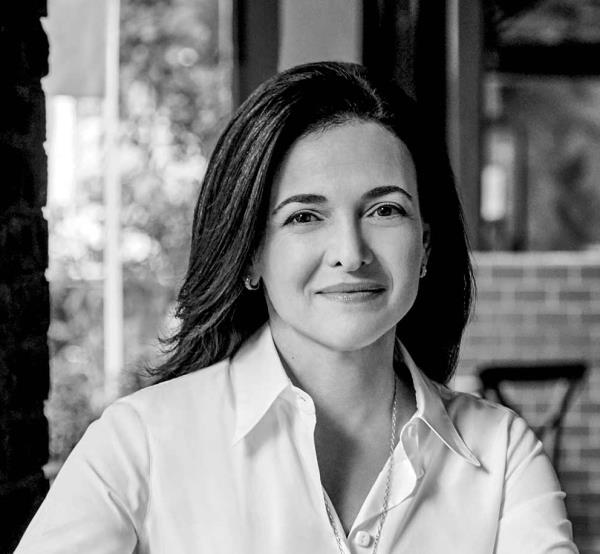06-04
06-04
06-04
06-04
06-04
更新时间:2022-04-08 09:56:46作者:潘星教育网阅读量:127
06-04
06-04
06-04
06-04
06-04


Facebook首席运营官谢丽尔·桑德伯格(Sheryl Sandberg),被媒体成为“Facebook第一夫人”。2015年春,她的丈夫戴夫·戈德伯格(Dave Goldberg)因心脏病意外离世。
经过艰难地在家庭和工作中重建平衡后,桑德伯格把自己的痛苦写下来并将其发表到Facebook上(桑德伯格在Facebook任COO并拥有近200万粉丝)。这篇文章在全球引发了一场如何面对不幸和伤痛的讨论。
在努力重回正轨的过程中,桑德伯格向朋友亚当·格兰特(Adam Grant)寻求帮助。格兰特是沃顿商学院的教授,也是一位作家。桑德伯格想知道,相关研究对于复原力和韧性(resilience)有什么成果。这最终促成两人合著了新书《选项B:直面逆境,培养复原力,寻获喜悦》(Option B: Facing Adversity, Building Resilience, and Finding Joy)。这本书已经上市。
桑德伯格和格兰特在Facebook加州门罗帕克(Menlo Park)总部接受了《哈佛商业评论》的采访,介绍如何在个人、团队和组织层面培养复原力。
以下是经过编辑的部分访谈内容。
HBR:对于正在经历困境的人,你会建议他们尽快回到工作中吗?
桑德伯格:绝对不会。伤心的方式不止一种,出路也不止一种。你需要的时间不同于我需要的时间。《选项B》中有一个故事:一位女性在丈夫去世第二天就回去工作,但感到同事们有看法。可是她又受不了待在家中,需要一个可以去的地方。每个人都要找到自己的出路。有些人可能需要几个月或更长时间。至于和别人分享,也是同样道理。为打破被隔绝的状态,我最后选择彻底公开分享,这是我一开始没想到的。但也有人不愿分享。我们必须尊重每个人的情感和不同的时间需求。
当同事遭遇不幸
HBR:员工在个人生活中若遇到危机,公司该如何应对?
格兰特:研究显示,企业如果设立制度,在员工遇到危机时(如房屋被龙卷风破坏、需要照顾重病家人等)给予经济支持或额外休假等帮助,将得到回报。员工会感到自己属于一个人性化的组织,并因此感到骄傲、对组织更忠诚。所以出现这种情况时,企业确实需要承担更多责任。
HBR:面对同事的不幸,人们通常不知道该说什么,所以就什么都不说,或者说错话。你对此有什么建议?
桑德伯格:最重要的是,要承认痛苦。要正视这个绝对不可能回避的事实。戴夫去世前,如果有同事被诊断出癌症或失去伴侣,我会告诉他们我很难过,但不会再主动提起——我不想去“提醒”他们。失去戴夫,我才知道这样做很荒谬。我记得我失去了丈夫,不存在你“提醒”的问题。要直面现实。“我知道这段时间对你和孩子们很难熬,你还好吗?”——这样的话会起到安慰作用。“你会走出来的”,这样说的人是善良的;但相比之下,说“我们会走出来的”要贴心得多。
HBR:如果别人问他们能做些什么,这会有帮助吗?
桑德伯格:这是友好的表示。但让处于痛苦中的人寻求帮助,或去想需要什么帮助,反而会加重他们的负担。当你悲伤得不能自已,你还能去要求什么?我在Facebook的同事丹·莱维(Dan Levy)的儿子病得很重,最后不幸离世。丹在医院时,一个帮他买汉堡的朋友在短信中问:“你的汉堡里不加什么?”而不是问“你需要什么吗?”做些具体的事情,会带来巨大帮助。
“创伤后成长”
HBR:复原力指的是恢复原初状态的能力。但你也写到了“创伤后成长”。这个概念指什么?
格兰特:提出这个概念的是两位心理学家,理查德·泰德斯奇(Richard Tedeschi)和劳伦斯·卡尔霍恩(Lawrence Calhoun)。他们在与一些失去孩子的父母相处时发现,有些父母除了巨大的悲伤外,还感到生活中发生了某种积极变化。此后,这一领域的整个研究圈子都试图弄明白,从创伤中成长意味着什么。很多人最终都感觉自己变得更强大。他们会说,“我从这件事中走出来了,我能克服任何困难”。有些人对仍然拥有的东西感恩。有些人发展出了比以往更具深度的人际关系。有些人找到了新的意义和人生目标,希望能有所成。
HBR:有没有可能不经历人生变故,也获得你们说的这些成长?
格兰特:这个问题是此次我们合作中最有意思的关注点之一。我们的合作是将谢丽尔的亲身经历置于社会科学的角度进行研究。谢丽尔因为这个问题而提出:“既然有‘创伤后成长’,为什么不能有‘创伤前成长’呢?”;而我则在疑问“创伤前?”……不过这是个很棒的想法。人们不必一定要通过惨痛经历才能学到这些经验。
HBR:你见过创伤前成长的例子吗?
桑德伯格:戴夫去世后,我的朋友凯蒂·米迪奇(Katie Mitic)受到触动,开始在她的朋友过生日时给他们写长信,说出她爱他们、欣赏他们的原因。其中有些人开始仿效她的做法。这是加深友情、找到意义和学会感恩的好方法,而你不必经历任何创伤。我觉得我们培养复原力,是为任何可能遇到的逆境做准备。我们都会遭遇逆境;每个人都有必须面对的选项B。
如何培养复原力
HBR:培养复原力有什么基本方法吗?
格兰特:在工作中,最有效的方法是从失败中学习。我们都会失败,都会犯错误。直面失败和错误可能极其困难,但这是我们培养复原力的惟一方式。我是在读研究生时明白这点的。我当时特别害怕对着一群人讲话,但要想当老师就必须克服这点。所以我努力去寻求反馈。我主动要求在别人班上讲课,然后请听众填写反馈意见表。阅读这些反馈相当不好受(有一个人说我太紧张了,以至于学生们在下面跟着发抖),但它让我知道了自己最根本的错误,并设定了改进目标。我们都应该把这种开放态度带进工作中,鼓励他人批评我们、帮助我们进步。
HBR:大家都在说从失败中学习,但很多公司做得并不好。原因何在?
格兰特:我觉得答案很简单,就是自尊心。我们都知道,如果将失败视作机会,就会让我们变得更好。但我不知道谁会为了“从失败中学习”而极尽所能把事情搞砸。所以失败发生时我们往往没有防备,然后我们就开始捍卫自尊心和自己的形象,并向自己和他人证明我们不愚蠢。而这就会妨碍提高自我和不断进步。
HBR:如何学着更建设性地对待失败?
格兰特:在与高管合作时,我不仅让他们对自己一段时间内的工作表现打分,也对后续接受反馈的态度打分。他们对待反馈的开放性真让人吃惊,尤其是工作成绩突出的人,他们真的很想得到A!
HBR:如何打造一个能从失败中获取价值的组织?
格兰特:首先,要营造能对失败和错误畅所欲言的文化。哈佛商学院的艾米·埃德蒙森(Amy Edmondson)研究过一些医院如何避免重大医疗失误的方法。她发现,如果医疗团队具备心理安全感,愿意承担风险并勇于承认错误,且不会因为无心之过受罚,他们就能学到更多、少犯错误。
HBR:复原力强的公司能有效适应环境变化,其中关键是什么?
格兰特:应对困难的速度和力量为复原力的关键。最好的做法是,建立一套能在意外情况下发挥作用的规范制度。马斯克的SpaceX是个有趣的例子。他告诉我,因为火箭发射一次次失败,他让人列出10项最大的失败风险(实际上,后来有一次爆炸是由十大风险之外的因素导致的;所以教训可能是,应该找出11项最大风险)。高度稳定的组织知道如何确立这些规范。它们巨细靡遗地列出所有可能出问题的关注点,在行动前逐一检查,而且每次出现意料之外的问题,都会将其补充进清单。
HBR:《哈佛商业评论》曾有几篇文章谈到,通过暂时放下工作,如休假、关掉电子设备等,你能够提升复原力。
格兰特:很多证据都支持这个观点。不过,我个人觉得我们通常对“休息”理解得太窄。加州大学戴维斯分校的金·埃尔斯巴赫(Kim Elsbach)的研究发现,休息的最好方式是去做不用动脑筋的工作。重复性工作可以释放脑力,有助于创造性思考。随着我们不断进步、掌握更复杂的技能,我们错误地排斥了重复性工作。在高难度、创造性工作的间隙,做几分钟在电子表格中输入数据之类的活,能帮助我们恢复能量。
HBR:很多人说幽默感对复原力很重要。在最黑暗的时刻,你如何保持幽默感?
桑德伯格:我觉得幽默感极其重要。我们这本书的编辑奈尔·斯科维尔(Nell Scovell)是一位电视喜剧编剧,有四个兄弟姐妹。在母亲的葬礼上,她手拿一个信封站起来说道:“这个信封里写着我们的妈妈最喜欢哪个孩子。”在最痛苦的时候还能笑出来,哪怕只有一秒钟,哪怕是关于不幸事件的本身,都能大大释放压力。它让你觉得,“天哪,这会过去的”。
HBR:你写到如何帮助孩子培养韧性,其中一种方式是让他们认识到自己的优势。这种方式对公司员工也有作用吗?
格兰特:我认为是这样。只不过为人父母比领导团队难得多。对于孩子们的韧性,“自己是重要的”这一观念非常重要。他们需要相信别人注意他、关心他、依靠他。如果孩子们感到自己无关紧要,可能会造成非常严重的后果,如犯罪倾向、反社会行为、攻击性等。同样道理,领导者有责任让每名员工都感到自己是重要的、受关注的。这是“走动式管理”如此流行的原因之一。你还应该让员工感到被依靠。很多领导者不敢去寻求帮助,但员工希望感到他们的贡献有价值。在领导者的行动中,最有力量的一种方式就是说“我现在不知道答案”。
殷阿笛是《哈佛商业评论》英文版总编辑。
王晨 | 译 蒋荟蓉 | 校 王晓红 | 编辑
阅读更多商业女性专题文章
请点击卡片进入“i哈评”小程序
附部分英文采访摘要
Would you advise people coping with a difficult personal situation to reengage with their work life as quickly as possible?
Sandberg: Absolutely not. There’s no one way to grieve, and there’s no one path. The timing for one person is not the timing for another. In the book we share the story of a woman who went back to work the day after her husband died and felt judged by her colleagues. But she just couldn’t bear to be home, and she needed somewhere else to go. Other people may need months or longer. Everyone has to find their own path. The same is true of how much sharing you want to do. I ended up sharing much more openly than I would have expected, to break through the isolation. But some people don’t want to share. We have to respect everyone’s timing and feelings.
When a Colleague Suffers a Loss
How should companies respond when employees are coping with a personal crisis?
Adam Grant: Research shows that companies with assistance programs that provide financial support or time off in a crisis—when an employee’s house is destroyed by a tornado, or when he or she has to care for somebody who is very ill—actually see dividends. People feel they belong to a more caring company. They take pride in their company as a “human” place to work and are more committed to it. There’s a real case to be made for organizations to step up.
“Posttraumatic Growth”
Resilience means snapping back to where you had previously been. But you also write about “post-traumatic growth.” What’s the idea behind that?
Grant: A pair of psychologists, Richard Tedeschi and Lawrence Calhoun, put this on the map. They were working with parents who had lost a child. Parents said that in addition to the tremendous pain they felt, they experienced some positive changes in their lives. A whole community of researchers then tried to figure out what it means to grow from trauma. Many people eventually felt stronger. They said, “I got through this; I can get through anything.” Some people found gratitude for what they still had. Some formed deeper relationships than they’d experienced before. And some felt a new sense of meaning and purpose—they wanted to make something of their lives.
Is it possible to develop in these ways without first experiencing catastrophe?
Grant: This is one of the really interesting things about working together—the juxtaposition of social science and Sheryl’s lived experiences. Sheryl responded to all this by saying, If we have posttraumatic growth, why don’t we have pretraumatic growth? And I was like, pre-what? But this is a great concept; people shouldn’t have to experience horrible events to learn some of these lessons.
Have you seen examples of pre-traumatic growth?
Sandberg: After Dave died, my friend Katie Mitic was inspired to start writing long letters to her friends on their birthdays telling them why she loved and appreciated them. Some of her friends started doing the same. That’s a good way to deepen relationships and find meaning and gratitude—before any trauma. I think we build resilience to prepare for whatever adversity we’ll face. And we all face some adversity—we’re all living some form of Option B.
Building Resilience
Is there a tool kit for developing resilience?
Grant: At work, the most powerful thing is learning from failure. We all fail; we all make mistakes. It can be incredibly difficult to face them, but that’s the only way we can build resilience. I learned this when I was in grad school. I was terrified of public speaking, but I had to do it to be a teacher. So I tried to get feedback. I volunteered to give guest lectures for other people’s classes, and afterward I gave out feedback forms. Reading them was unpleasant (one said I was so nervous I was causing the students to physically shake in their seats), but I learned what my systematic mistakes were, and I was able to set goals to try to improve. It would be great to bring that kind of openness to our jobs—to encourage others to critique us and help us improve.
Everyone talks about learning from failure, but a lot of companies don’t do it very well. Why is that?
Grant: I think the simple answer is ego. We all know that failure can make us better if we treat it as a learning opportunity. But I don’t know anyone who says they want to screw up as badly as they can just to learn. So when we fail, it tends to catch us off guard. And then we get in a mode of trying to defend our ego and our image, to prove to ourselves and others that we’re not stupid. That stands in the way of improving and making progress.
How can we learn to handle failure more constructively?
Grant: When I work with executives, I ask them to score not only their performance in a given episode but also how well they take feedback afterward. It’s amazing how open they become to feedback, especially the overachievers—they really want to get an A!
How do you design an organization that fails well?
Grant: The first thing is to create a culture where people can talk openly about their failures and mistakes. Amy Edmondson of Harvard Business School has studied hospitals to figure out how they can prevent major medical errors. She found that teams learned more and could avoid problems if they had a sense of psychological safety—if they could take risks and be open about mistakes, if they weren’t going to be punished for honest errors.
Resilient companies also adapt effectively to changing circumstances. What’s the key to that?
Grant: Resilience is about the speed and strength of your response to adversity. The best thing you can do is build routines that might be applicable in an unexpected situation. SpaceX is an interesting example. CEO Elon Musk told us that because the rockets had failed over and over again, he asked people for a list of the 10 biggest launch risks. (It turned out that one explosion was caused by the 11th risk, so maybe the lesson is to ask for the top 11.) High-reliability organizations know how to set these routines in place. They make exhaustive lists of things that could go wrong, they precheck them, and then every time they have an unexpected failure, they expand the list.
HBR has run articles showing that you can cultivate personal resilience by taking some downtime, via scheduled or unscheduled breaks, or by cutting yourself off from technology.
Grant: A lot of evidence speaks to that. But I think we tend to define breaks too narrowly. Kim Elsbach of UC Davis has done research showing that one of the best ways to give people a break is to assign them mindless work. Rote tasks can free up your mind to think creatively. As people advance and develop more-complicated skills, we make the mistake of taking repetitive tasks off their plates. Switching between challenging, creative problems and, say, entering data into a spreadsheet for a few minutes can help us recharge.
It’s often said that a sense of humor is vital to resilience. How do you access humor in the darkest moments?
Sandberg: I think humor is huge. Nell Scovell, who edited our book, is a TV comedy writer with four siblings. At her mother’s funeral, she stood up with an envelope and said, “I have in this envelope the name of Mom’s favorite child.” In those really dark moments, being able to laugh, even for a second—even about the event itself—is a huge stress release. It makes you feel, “Oh my God, it’ll be OK.”
You write about how to build resilience in kids, in part by helping them understand their strengths. Is this a model for helping employees as well?
Grant: I think so, with the caveat that parenting is way harder than leadership. One of the drivers of resilience in kids is “mattering”—the belief that other people notice you, care about you, rely on you. When kids feel they don’t matter, the consequences can be devastating: delinquent and antisocial behavior, aggression. Along those lines, it is every leader’s responsibility to make every single employee know that they matter, to show that they’re noticed. That’s one of the reasons management by walking around is so popular. You also want to make employees feel relied on. Many leaders are afraid to ask for help, but people want to know that their contributions have an impact. One of the most powerful things a leader can do is say, “I don’t know the answer here.”
为什么那么多女性反感职场政治?
想找到合适的CEO,就从部门主管中挑吧
挑战算法的女骑手 | 三八特别策划

投稿、广告、内容和商务合作
相关文章
版权声明:部分内容为互联网整合,文中观点不代表本站立场。本站仅提供信息存储空间服务,不拥有所有权,不承担相关法律责任。如发现本站有涉嫌抄袭侵权/违法违规的内容,请发送邮件举报,一经查实,本站将立刻删除。
精品文章
热门推荐